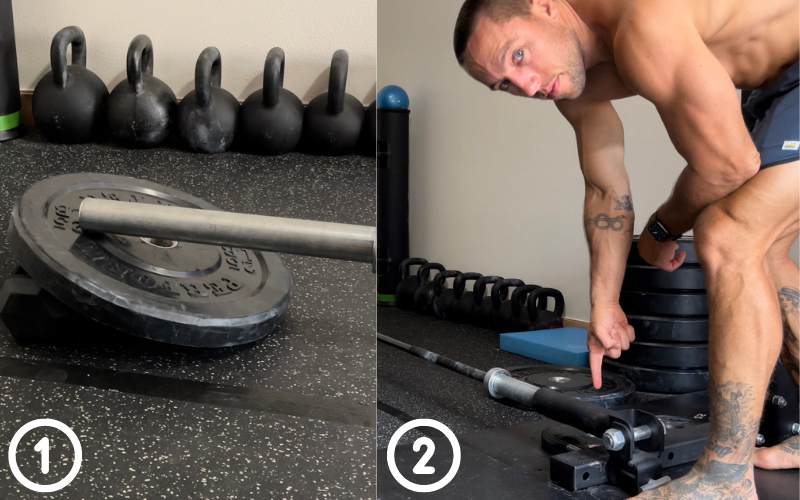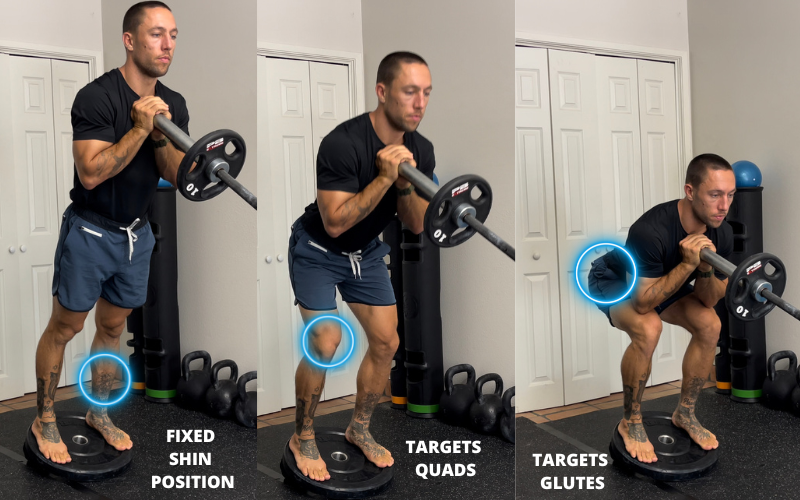
3 Landmine Exercises To Improve Leg Endurance For Skiing
Have you ever wondered how you can mimic the angle of the ski hill while strength training? Not everyone has access to a SKICOSMOS Ski Simulator, and even then, the simulator doesn’t present forward pitch, rather, it challenges the lower extremities through lateral changes in loading across a flat surface.
Here’s where the landmine comes in. Simply put the landmine is a barbell shoved into one of two things: a landmine attachment, which you will see below, or a rolled up towel in the corner of the room. Either works perfectly fine, however, the towel will provide less stability and limit your future strength improvements.

- Equipment: barbell, weight plate or flat stable surface, dumbbell for elevation
- Fixed landmine attachment from Rogue. You can use a towel or shirt shoved in a corner as well.
When you anchor one side of a barbell and create the landmine, it fixes the position and allows the other end of the barbell to move within a specific angular range of motion. So how does this help skiing?
Through modifying your base, as you will again see in these photos, you can create a foot position that nearly replicates that of your ski boot. The shin angle stays relatively vertical, much like a ski boot, yet allows the upper body to move AGAINST the anchor point of the barbell.
By being able to lean into the barbell without falling over, you can train the squat, step up, deadlift, reverse lunge, and even lateral reverse lunge from the floor to as high of an angle as you can maintain.
I like to place one dumbbell under the weight plate to create roughly a 45 degree angle for my shin. This feels the most like skiing through the squat movement, and it’s flat enough to support my feet without them slipping.
In the following pictures, you will find my three go-to skier movements to help build legs that will crush long runs, and rip through chunky snow.
LANDMINE SQUAT

No squat will replicate the burn you feel skiing more than the Landmine Squat. You can operate through the full range of motion or cut the range in half and pulse up and down. This cyclical movement pattern will train your legs to resist fatigue following long runs and linked turns. Load up as heavy as you want, or go lighter and complete reps for time.
Sets: 2-4
Reps: 12+ , or continuous for 45 sec - 2 min (length of a ski run)
Resistance: 25-28% of your back squat
LATERAL SINGLE LEG LOADED REVERSE LUNGE

This exercise is fantastic for training ankle stability of the stance leg, single leg strength (you’ll notice one leg is weaker than the other), and core stability. Because the weight is held by both arms, at your chest, it will place significant stress on your core muscles and balance as you pass the rear leg back.
For increased stability, inhale, brace, and then descend into the lunge. As you rise, exhale sharply, contracting your stomach muscles, and “own” the start position.
As you decrease the discrepancy in balance and strength of your legs over time, you will feel a massive improvement through your edge turnover while skiing.
Sets: 2-3
Reps: 6-8/Leg
Resistance: 25% of Back Squat or something that feels like an 8/10 difficulty by the last rep.
SINGLE LEG LOADED REVERSE LUNGE

Similar to the lateral version, this trains ankle stability, trunk stability, and quad strength in a single leg set up. The benefit of doing this exercise in conjunction with the above exercise is that you cover both lines of pull; lateral and vertical.
This version will challenge the lateral stability of your ankle less, and the strength of your quad more. You will be able to load slightly more weight due to the natural forward position. For an added challenge you can hold the landmine with only one arm and feel the decrease in balance. Tighten your core muscles and center yourself before each rep.
Sets: 2-3
Reps: 6-8/Leg
Resistance: 25% of Back Squat or something that feels like an 8/10 difficulty by the last rep.
TAKE AWAY
If you add these three exercises to your regiment and improve your strength even 5%, you will be astonished at how much more stable you are on snow. You will have more unilateral strength which is crucial for skiing considering the constantly changing responsibility that each leg possesses through various points in the turn.
Start slow, build slow, trust the process, and stay consistent.
If you liked this article, send it to a friend!
Thanks,
Abe